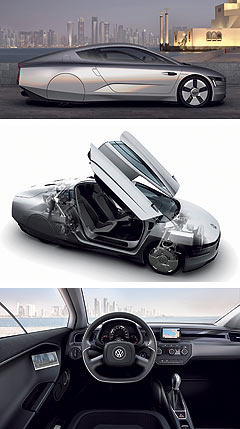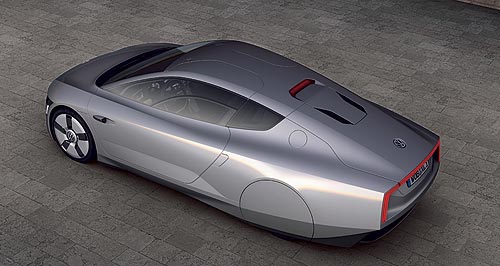Make / Model Search
Future models - Volkswagen - XL1 - ConceptSlippery hybrid VW sips just 0.9L/100kmFuel miser: Volkswagen's latest attempt at an ultimate fuel-efficient car, the XL1, uses a plug-in electric diesel powertrain. Plug-in diesel Volkswagen XL1 concept pushes the barriers of fuel efficiency26 Jan 2011 VOLKSWAGEN chose the hub of world oil production, the Middle East, to unveil one of the world’s most fuel-efficient vehicles, the VW XL1, with company chiefs announcing that they hoped to put the car into limited series production in 2013. The tear-drop-shaped plug-in diesel-hybrid car can return a remarkable 0.9 litres per 100km (331mpg) on the combined fuel test while emitting just 24 grams of carbon dioxide per kilometre. This compares with 3.9L/100km and 89g/km for the Toyota Prius hybrid. Automotive News quoted VW Group executives at the Qatar Motor Show in Doha, where the two-seat XL1 was revealed, as saying up to 100 cars could be built, with roll out starting in Germany and then followed by the United States and China. The project to develop the XL1 was the vision of Volkswagen AG board chairman Ferdinand Piëch who announced in 2000 that VW would work towards a practical, everyday production car with a fuel consumption of 1.0L/100km. Since then, VW has presented two other ultra-low fuel consumption prototypes, 2002’s single-seat 1-Litre car and the L1 concept in 2009, as it works towards the goal. Mr Piech was in Doha to see the XL1 unveiled this week, telling Automotive News: “We want to go into series production with this car starting in 2013,” adding that the car would “certainly be for sale”.  The latest effort weighs a featherweight 795kg and is powered by a 35kW 800cc twin-cylinder diesel engine linked with a 20kW electric motor for a total of 55kW, driving the rear wheels through a seven-speed dual-clutch transmission with an automatic clutch between each motor. The latest effort weighs a featherweight 795kg and is powered by a 35kW 800cc twin-cylinder diesel engine linked with a 20kW electric motor for a total of 55kW, driving the rear wheels through a seven-speed dual-clutch transmission with an automatic clutch between each motor.The electric motor can work independently of the diesel engine or in tandem when more power is needed for accelerating. In pure electric mode, the XL1 can travel up to 35km before the diesel engine cuts in. The sprint from zero to 100km/h takes a respectable 11.9 seconds, and the top speed is 160km/h. Volkswagen says the aerodynamic styling – which includes covered rear wheels to reduce drag – boasts a drag coefficient of just 0.186, making it one of the most aerodynamic vehicles in existence. Toyota’s Prius is 0.25Cd. The body shape is aided by the interior packaging, with staggered side-by-side seating for the driver and passenger. The body uses pioneering composite construction, tipping the scales at just 230kg. contruction involved a newly patented system for the Carbon Fibre Reinforced Polymer (CFRP) parts, which VW calls the Resin Transfer Moulding (RTM) process. The drivetrain is said to weigh just 227kg, while the running gear adds 153kg. Further savings are made through the extensive use of lightweight materials including magnesium (wheels), ceramics (brake discs) and aluminium (dampers, steering system, brake callipers). Inside, the bucket seats and other fittings are all of light materials. In all, just 23.2 per cent of the vehicle is made from steel or iron. In typical concept car fashion, the doors are scissor style, hinging on the A-pillar. The Polo-sized XL1 is 3970mmlong and 1682mm wide, although the low roof height – just 1184 mm, is more akin to that of a Lamborghini Gallardo Spyder. Small cameras are used for rear vision, eliminating mirrors.  Read moreAll future models Alfa Romeo Alfa Romeo Abarth Abarth Alpine Alpine Alpina Alpina Audi Audi Aston Martin Aston Martin BMW BMW Bentley Bentley Chery Chery Brabham Brabham Chrysler Chrysler Chevrolet Chevrolet Cupra Cupra Citroen Citroen DS DS Dodge Dodge Fiat Fiat Ferrari Ferrari Foton Foton Ford Ford Great Wall Great Wall FPV FPV Haval Haval GWM GWM Honda Honda Holden Holden Hummer Hummer HSV HSV Infiniti Infiniti Hyundai Hyundai Jaguar Jaguar Isuzu Isuzu Kia Kia Jeep Jeep Land Rover Land Rover Lamborghini Lamborghini Lexus Lexus LDV LDV Mahindra Mahindra Lotus Lotus Mazda Mazda Maserati Maserati Mercedes-AMG Mercedes-AMG McLaren McLaren MG MG Mercedes-Benz Mercedes-Benz Mitsubishi Mitsubishi Mini Mini Opel Opel Nissan Nissan Peugeot Peugeot Pagani Pagani Proton Proton Porsche Porsche Renault Renault Ram Ram Rover Rover Rolls-Royce Rolls-Royce Skoda Skoda Saab Saab SsangYong SsangYong Smart Smart Suzuki Suzuki Subaru Subaru Toyota Toyota Tesla Tesla Volvo VolvoMotor industry news |
Click to shareVolkswagen modelsResearch Volkswagen All future models Alfa Romeo Alfa Romeo Abarth Abarth Alpine Alpine Alpina Alpina Audi Audi Aston Martin Aston Martin BMW BMW Bentley Bentley Chery Chery Brabham Brabham Chrysler Chrysler Chevrolet Chevrolet Cupra Cupra Citroen Citroen DS DS Dodge Dodge Fiat Fiat Ferrari Ferrari Foton Foton Ford Ford Great Wall Great Wall FPV FPV Haval Haval GWM GWM Honda Honda Holden Holden Hummer Hummer HSV HSV Infiniti Infiniti Hyundai Hyundai Jaguar Jaguar Isuzu Isuzu Kia Kia Jeep Jeep Land Rover Land Rover Lamborghini Lamborghini Lexus Lexus LDV LDV Mahindra Mahindra Lotus Lotus Mazda Mazda Maserati Maserati Mercedes-AMG Mercedes-AMG McLaren McLaren MG MG Mercedes-Benz Mercedes-Benz Mitsubishi Mitsubishi Mini Mini Opel Opel Nissan Nissan Peugeot Peugeot Pagani Pagani Proton Proton Porsche Porsche Renault Renault Ram Ram Rover Rover Rolls-Royce Rolls-Royce Skoda Skoda Saab Saab SsangYong SsangYong Smart Smart Suzuki Suzuki Subaru Subaru Toyota Toyota Tesla Tesla Volvo VolvoMotor industry news |











Facebook Twitter Instagram